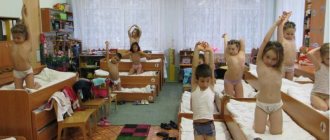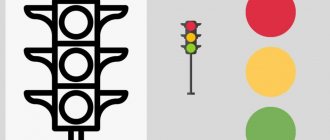Card index of active and sedentary games and game exercises for senior and preparatory groups
Game exercises
"Rope walker."
A rope is laid on the site. Children walk in a column, keeping a distance of at least 60-70cm from each other, put a bag of sand on their heads, arms at their sides, and try to walk so that the bag does not fall. The second time they pass sideways, the third time - sideways, but with an extra step. Those who maintained an even posture and whose bag did not fall are noted.
"Champion of the Jump Rope."
Children take one rope at a time and stand at the starting line. The distance from the starting line to the finish is 8-10m. When the teacher whistles, the children begin to skip and jump over the rope, saying a rhyme to the finish line.
"Running in threes."
Children are divided into groups of 3 people. The extreme participants stand with their backs towards the control landmark (pin, flag), and the middle one faces it. Everyone joins hands and, at the teacher’s signal, begins to run to the landmark. Having reached it, they change places and run back to the start: the middle one with their backs, and the extreme ones with their faces. The first three to complete the competition wins.
Card 21
Outdoor game “Defense of fortifications”
Children stand in a circle. Using a counting rhyme, a defender is selected to protect the pin standing in a small drawn circle in the center of a large one. Players try to hit the pin with the ball. The ball can be thrown, but the thrower cannot leave the general circle and change place. The one who manages to knock down the pin takes the place of the defender.
Sedentary game "Stream"
Children become pairs, holding hands, stand one after another and form a long “corridor”, raising their arms up. One child, left without a partner, begins to flow as a stream. He enters the stream from the end of the “corridor” and goes to the beginning of the stream, taking by the hand a friend from any pair he wants. The child left without a partner walks away from the stream to the end of the “corridor”, then enters the stream, taking the hand of whomever he wants. wants, etc. Thus, the stream flows slowly, moving forward.
Game exercises
"Roll the ball."
Children sit on the floor in one line, legs stretched out and hands resting on the floor, each with a ball. At the teacher’s signal, everyone moves forward with their hands, rolling the ball with their feet. The one who reaches the finish line first wins. Distance - up to 5m.
"Sharp blow."
A ball is placed on the ground. The player takes 7-10 steps from him and stops. The physical education teacher blindfolds him. At the signal, the player turns and walks towards the goal. When, according to his calculations, he has come close enough, he kicks the ball. If you hit it, you win.
Card 22
Outdoor game “Horses and runners”
A playing area of 3x3 or 5x5 m is outlined. Children are divided into two teams: horses and runners. On one side of the site is the horse house. Runners run around the playing area within its boundaries. The horses send one of their team to the field (to the site). The horse catches runners by jumping on one leg. The physical education teacher calls the horse: “Home!” He returns, and the next player in line jumps into the field instead. And so the horses change all the time. The caught runners are captured by the horses. The game ends when all players in the field are overfished. Then the teams change roles. The game repeats itself.
1. Throwing the ball up and catching it with both hands (at least 20 times in a row).
2. Throwing the ball up and catching it with one hand (at least 10 times in a row).
3. Throwing the ball to each other with a clap, with a turn, with a bounce off the ground, in an oblique direction.
4. Throwing the ball to each other in different positions: standing with your face and back, kneeling, sitting cross-legged, lying down.
5. Rolling a medicine ball at each other.
6. Throwing a medicine ball forward from below, from the chest, over the head back.
7. Hitting the ball on the ground alternately with one and the other hand several times in a row.
8. Hit the ball on the ground with both hands, running at a distance of 6-8 m.
9. Hit the ball on the ground with one hand, moving forward in a straight direction.
10. Hit the ball on the ground, moving in a circle.
11. Hit the ball on the ground, moving like a snake.
12. Throwing at a horizontal target with the right and left hands at a distance of 4-5 m.
13.Throwing into the distance at a distance of 6-12 m with the right and left hand.
14. Throwing at a vertical target with the right and left hands.
15. Throwing at a target from starting positions kneeling, sitting, lying down.
16. Throwing at a moving target with the right and left hands.
17.Throwing into the distance from several steps. .
18. Throwing the ball into a basketball basket from a place and from 2-3 steps.
19. Hitting the ball through the net by several players with a pass to each other (elements of volleyball).
20. Throwing and catching a ball from a wall with different tasks: with a bounce off the ground, with a turn in a circle, in an oblique direction, with jumping over a bounced ball.
21. Throwing objects of different weights and shapes into the distance and upwards (balls, bags, sticks, cardboard discs, rods - darts, etc.).
Guidelines . In the preparatory group, the teacher tries to reinforce the correct ways for children to perform
rolling, throwing and catching, throwing at a target and into the distance. Significantly increases with
This is the role of independent actions with the ball. Good ball control allows children to be offered more complex tasks: throwing and catching in different positions (standing with their face and back, kneeling, sitting cross-legged, lying down, (picture). Children 6-7 years old can throw a medicine ball with two hands in different ways: from below, from the chest, from behind the head.Tasks become more difficult, including hitting the ball on the ground with two and one hand (picture on the right).
The teacher seeks from children good control over the movement of the ball, the ability to gently push it away with their fingers, and hit the ground on the side of their foot. Training in dribbling the ball with the right and left hands is required. If the children complete the task easily and at ease, you can offer to dribble the ball along a path bounded by lines, zigzag between objects, around a large hoop, trying to complete the movement as quickly as possible. It is good to combine dribbling the ball with throwing it into the basketball basket.
Children throw at a target much more accurately, so it is advisable to reduce the size of the target to 15-10 cm and increase the distance to it. A moving target is introduced, and outdoor games like “Knock the Hoop Down” are used more often.
Throwing and throwing skills are consolidated in games that bring together groups of children: ring throws (horizontal, inclined), serso. Sports exercises should also be used more widely: table tennis, gorodki, badminton. At the play wall, children improve their movements; they themselves can think of interesting ways to hit and catch the ball: from under the hand, in a jump, in a squat, standing with their backs, etc.
Exercises and games for children 6-7 years old
Accurate strike . Two teams of 8-10 children line up columns one at a time, one against the other. Between them there is a hoop or a drawn circle (diameter 1 m). At the signal, the first from one team throws the ball into the center, circles at an angle so that it bounces to the first from the other team, and moves to the side. Throws from the first player of the second team to the second player from the first team. So, taking turns, the children of both teams throw and catch the ball. The team that finishes the game earlier or has fewer misses wins.
Rules: throw the ball into the hoop; if the ball hits the hoop, the throw is performed again; the child who did not catch the ball catches it again, but the next child in the column throws it to him.
Don't miss the ball . Children are distributed in pairs, each team has a ball. One of the pair hits the ball on the floor the agreed number of times (4-6) and passes the ball to the second in the pair. The winner is the pair that manages to keep the ball in play longer than others.
Rules: the ball is passed without stopping; the player who lost the ball is eliminated from the game, and his partner waits until the one who lost the ball comes out of any pair, and continues the game with the remaining player.
Passed it on - sit down . The players line up in 3-4 columns. In front of each, at a distance of 1 m, there are drivers in circles, they each have a ball. At the signal, each driver throws the ball to the first player in his column. Having caught the ball, the child throws it to the driver and sits on the ground. The drivers throw the balls to the second player, then to the third player, etc. Having received the ball from the last player of his team, the driver raises it up, all members of his team quickly jump up. The team whose driver picked up the ball first and all the children managed to get up quickly wins.
Rules: the one who dropped the ball must pick it up, stand in place and throw it again to the driver, having thrown the ball, immediately sit on the ground, cross-legged; all players stand up after their driver has raised the ball up.
Knock down the hoop . Two children roll a hoop intertwined with strings along the path to each other. Two others, located on opposite sides, throw a soft ball, trying to knock down the hoop.
Rules: throw into the hoop without going beyond the line; Those who knocked down the hoop change roles with those who rolled.
Throw it, catch it! The players throw the ball over a stretched rope (height 1.2-1.5 m), run forward under it and catch the ball immediately or after bouncing off the ground.
Defense of the fortress. “They take three sticks, tie them at the top and place a rubber or volleyball ball on them - this is a fortress that the driver protects. The rest of the players, standing in a circle, throw the ball among themselves. They try to hit the ball at a convenient moment, when the driver turns away. The driver does not allow this to be done. The one who hits becomes the driver. .
Rules: you can throw the ball in a circle in any direction; The driver hits the flying ball in any way - with his foot, his hand.
Who is faster. Two players stand opposite each other at a distance of 10 m. Between them in a circle stands a small town or a tall cube. Children try to knock him down with a ball. The one who succeeds moves the town one step closer to himself. The one who moves the object closest to himself wins.
Catch the ball. Children are distributed in groups of three. Two of them stand at a distance of 2-3 m and throw the ball to each other. The third stands between them and tries to catch the ball or touch it with his hand.
Rules: the driver who touched the ball changes place with the one who threw the ball; The driver can catch up with the ball that has rolled away after an unsuccessful throw.
Shot into the sky . Children are divided into two teams and located around a outlined circle with a diameter of 10-12 steps. Two players from one and the other team go out into the circle with tennis balls and throw them vertically upward as high as possible. Whose ball stays “in the air longer” gets one point.
Rules: throw the ball up at the same time at the signal; Those who threw them take the balls after they bounce off the ground.
Horizontal target . Several concentric circles are drawn on the ground 4-5 steps from the throwing line. Children take turns throwing a regular or medicine ball with both hands from behind their heads. The hit is scored - the closer, the fewer points.
Rule: Falling outside the circle does not count.
Play, play, don't lose the ball! Children are located on the playground. Everyone plays with the ball, performing actions of their own choosing: throwing it up and on the ground, hitting the ball on the spot and in motion; throws the ball into the wall, into the basket. After the teacher’s signal, everyone must quickly raise the ball up.
Rules: play with the ball without disturbing your teammates, find a free space on the court; Those who fail to pick up the ball at the signal receive a penalty point.
Pass the ball. On the path, 8-10 pegs are driven into the ground at a distance of 1.5 m from one another. The player places the ball on the ground and moves it with his foot along the path, going around the pegs first to the right, then to the left (as if in a “snake”).
Rules: be sure to circle all the pegs with the ball without missing them; catch the rolled ball, put it in its place and continue rolling.
Basket target. A small basket is hung from a tree branch and swung. 2-3 players stand behind a steeple, marked at a distance of 3-4 steps from it, and try to throw some small objects into the basket, for example, one - fir cones, another - pine cones, the third - acorns. When the basket stops swinging, the abandoned items are counted. The one who has more items in the basket wins.
Rules: when throwing, you cannot enter the circle; throw one item at a time into the basket in any way.
Volleyball with balloons. Stretch the rope at approximately a height of 1.2 - 1.5 m. Tie two balloons together, into which you can pour a few drops of water. On both sides of the rope there are teams of 3-5 children in each: the players hit the balls, trying to drive them to the opponent’s side and not letting them fall on their side.
Rules: try to play together, passing the balls to the one who is more comfortable to return them to the other side; the team on whose side the balls landed is awarded a penalty point; Do not hold the balls with your hands, but hit them.
LiveInternetLiveInternet
Quote from Olia2010
Read in full In your quotation book or community!
Outdoor games and play exercises for children 3 - 4 years old, 4-5 years old
Outdoor games and play exercises for children 3 - 4 years old.
"Fast Bugs"
Crawling on all fours between objects with support on the palms and knees.
Jumping bunnies.
Jump on two legs, moving forward in a straight line to the cube. Distance 2.5 m. The child pretends to be a hare on the lawn.
Roll the ball.
On one side (from the starting line), the child rolls the ball in a straight direction, pushing it with both hands in front of him to the designated objects (cubes). He then takes the ball in his hands and lifts it above his head. The task is carried out 2 times. Distance – 4 – 5 m.
Get into the circle.
The child stands in one line on the starting line (cord), holding a bag in his hands (the second lies at his feet). Hoops are placed at a distance of 1.5 m from the child. At the signal “Quit!” the child throws the bag at the target, then throws the second bag.
Who will throw further?
The child stands on the starting line (beyond the conventional line), holding a bag in his hands. At the signal “Quit!” the child throws the bag into the distance. The reference point for throwing can be various objects - pins, cubes, balls, etc. You can place several bags near the child’s feet to increase the number of throws in one approach. At the end of throwing, the child runs after the bags.
Ride and catch up.
The child stands on the starting line (cord) with a large diameter ball in his hands. You need to roll the ball forward, and then catch it and lift it above your head. The exercise is repeated 2-3 times.
Catch a mosquito.
A cord (or rope) is tied to the end of a small rod or stick and a mosquito cut out of cardboard is attached to it. An adult rotates the rod over the child's head. The child jumps on two legs, trying to touch the mosquito and catch it.
Ride and knock down.
The child has a large diameter ball in his hands. A pin is placed at a distance of 2 m from it. The child rolls the ball, trying to knock down the pin.
Through the stream.
Several streams (3-4 pieces) are laid out from cords (or ropes). The width of each is 25 cm. The child jumps over each stream.
Throw the ball on the ground and catch it.
Stand with feet shoulder-width apart, ball in bent arms in front of you. You need to throw the ball with your toes and catch it with both hands.
Outdoor games and play exercises for children 4 - 5 years old.
"Little Bunnies"
The child pretends to be a rabbit. The child jumps on two legs and says the words: The bunnies gallop, hop, hop, hop, onto the green meadow. Skok, skok, skok, skok.
"Don't touch me"
Skittles (5-6 pieces) are placed in one line along the hall, the distance between them is 40 cm. When jumping on two legs like a snake between objects, you must not touch them.
"Who will throw further"
The child stands on the starting line (beyond the line), with one bag in his hands (the second lies at his feet on the floor). At the signal “Quit!” a child throws bags at a distance. The reference point can be cubes, skittles or other objects.
"Bear Cubs"
The child crawls on all fours, leaning on his palms and feet, like cubs, to the basket, then takes a large diameter ball from the basket, stands up and lifts the ball up above his head.
"Penguins"
An adult invites the child to hold the bag between his knees and jump on two legs, moving forward like penguins (distance 2 m).
Game exercises with a ball.
The child throws the ball up and catches it with both hands, throws it on the ground and catches it with both hands.
"Ball School"
Types of movements:
- Throw the ball up and catch it with both hands.
- Throw the ball up and, while it is flying, clap your hands in front of you.
- Hit the ball on the ground and catch it with both hands.
- Hit the ball on the ground, simultaneously clap your hands in front of you and catch it with both hands.
"Rent a hoop"
The adult stands opposite the child at a distance of 3 m. The adult holds a hoop in his hands. You need to place the hoop with the rim on the floor, place your left hand on top of the rim, and use the palm of your right hand to push the hoop so that it rolls.
“Step over - don’t touch”
Short cords (6 - 8 pieces) are placed on the floor at a distance of two steps for the child. The adult invites the child to step with his right and left foot alternately over each cord. The task develops coordination of movements.
“Walk through, don’t hurt me”
A task to maintain stable balance on an elevated support: walking on a gymnastic bench with a bag on the head, arms to the sides (or on the belt).
"Get in the cart"
The child stands at a distance of 1.5 meters from the basket. Throws bags into the basket - method with the right (left) hand from below, one leg in front, the other behind.
"Knock down the pin"
The child is located on the starting line 2 m from the pin, in his hands he has one large diameter ball. At the signal: “Let’s go!” the child rolls the ball, trying to knock down the pin.
"Jumping over a short rope"
A child performs jumping ropes on two legs.
"Through the Stream"
A stream 50 cm wide is laid out from the cords. The child jumps over the rope, turns around and jumps again.
Source: https://www.ivalex.vistcom.ru/konsultac271.html



